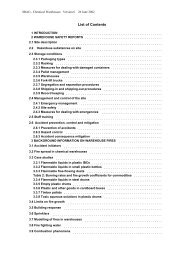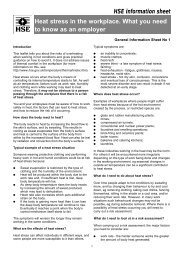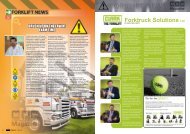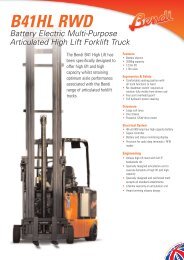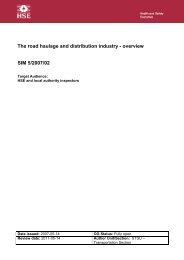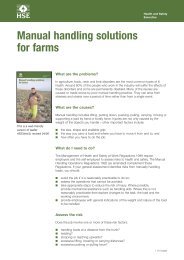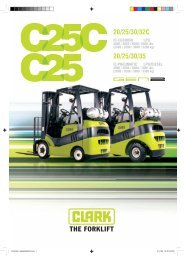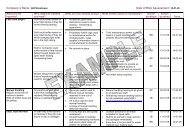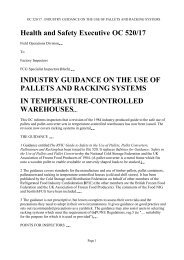Workplace transport inspection pack
Workplace transport inspection pack
Workplace transport inspection pack
Create successful ePaper yourself
Turn your PDF publications into a flip-book with our unique Google optimized e-Paper software.
indication of how well WT risks are being managed. " Any (un)loading activitiesinvolving WT near or on the public highway or pavement just outside a workplaceinvolves a high risk interface with the public (both pedestrians and vehicles) andrequires particular attention. See OM 2003/103 "Work related road trafficincidents: an explanation of circumstances where HSE may have a role to play",especially boxes 1 and 2 of the Appendix to the OM. Employers should be asked tojustify the need for any (un)loading involving WT taking place on or near the publichighway or pavement (by risk assessment). Risks can usually be reduced byrequiring (un)loading to take place within the premises, away from the public, in adesignated, demarcated, supervised area. Freeing-up such space may requiresignificant reorganisation of the site (for instance sacrificing some coveted staff carparking spaces?). OC 789/5 “Risks to the public from un/loading vehicles on thehighway” contains more detailed advice.Drawing up and enforcing simple written site rules for (un)loading can make itclear to all what’s expected. Such site rules (perhaps one A4 sheet) may be copiedby fax/electronically to suppliers when ordering goods, or to customers when takingorders for deliveries. The Freight Transport Association (FTA) have produced someexample forms in their Health and Safety Compliance Guide “Managing visitors,visiting vehicles and deliveries” due to be published in 2007. They can then bepassed to the delivery driver with the other in-cab paperwork for a delivery/collection.These simple, practical procedures can help site controllers and haulage companiesfulfil their duties to co-operate in ensuring safety.2.2 Safe site2.2.1 Pedestrian/vehicle separation76% of WT deaths (12 year aggregate) are "struck by vehicle" accidents, andinadequate pedestrian / vehicle segregation is a contributory factor to a largeproportion. The main vehicle groups involved are lorries, construction vehicles,tractors, forklift trucks.On some sites complete separation of vehicles and pedestrians will be achievable(apart from the need, for example, for drivers themselves to get to and from theirvehicles), but not on all. Reg 17 of the <strong>Workplace</strong> Regulations applies. See alsoPUWER ACoP paras 45 to 48 concerning the need to control risks to pedestriansand establish traffic rules where self-propelled mobile work equipment (paras 318and 319) operates. IEE (Initial enforcement expectation) - If at a particular sitepedestrian / vehicle segregation is clearly inadequate, consider enforcementby IN. The IN in the Notice Templates section gives one possible form of wording.For main issues to be considered, see paras 159 to 182 of the <strong>Workplace</strong> RegsACoP / guidance in booklet L24, and the WT Checklist.



